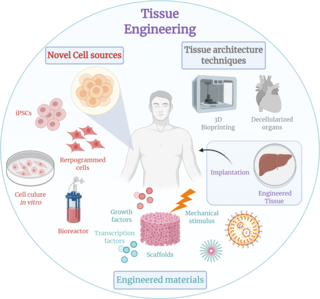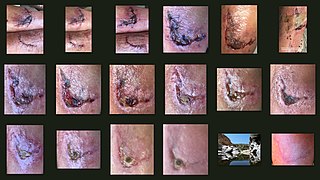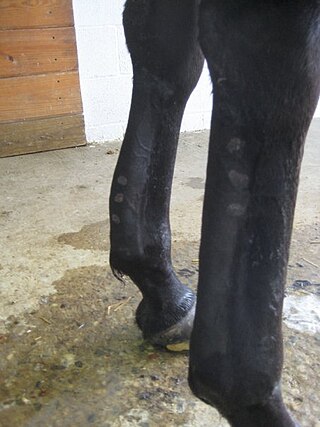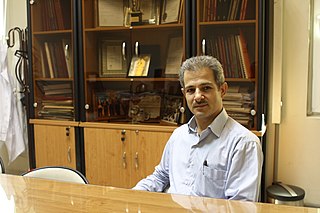Related Research Articles

Tissue engineering is a biomedical engineering discipline that uses a combination of cells, engineering, materials methods, and suitable biochemical and physicochemical factors to restore, maintain, improve, or replace different types of biological tissues. Tissue engineering often involves the use of cells placed on tissue scaffolds in the formation of new viable tissue for a medical purpose but is not limited to applications involving cells and tissue scaffolds. While it was once categorized as a sub-field of biomaterials, having grown in scope and importance it can be considered as a field of its own.

Wound healing refers to a living organism's replacement of destroyed or damaged tissue by newly produced tissue.

Tendinitis/tendonitis is inflammation of a tendon, often involving torn collagen fibers. A bowed tendon is a horseman's term for a tendon after a horse has sustained an injury that causes swelling in one or more tendons creating a "bowed" appearance.
Cardiomyoplasty is a surgical procedure in which healthy muscle from another part of the body is wrapped around the heart to provide support for the failing heart. Most often the latissimus dorsi muscle is used for this purpose. A special pacemaker is implanted to make the skeletal muscle contract. If cardiomyoplasty is successful and increased cardiac output is achieved, it usually acts as a bridging therapy, giving time for damaged myocardium to be treated in other ways, such as remodeling by cellular therapies.

Ellen Heber-Katz is an American immunologist and regeneration biologist who is a professor at Lankenau Institute for Medical Research (LIMR). She discovered that the Murphy Roths Large (MRL) mouse strain can regenerate wounds without scarring, and can fully restore damaged tissues. Her work on regeneration has been extended into National Cancer Institute (NCI)-funded studies of novel aspects of breast cancer causation. Her research interests include immunology, regenerative medicine and cancer.
A fibrin scaffold is a network of protein that holds together and supports a variety of living tissues. It is produced naturally by the body after injury, but also can be engineered as a tissue substitute to speed healing. The scaffold consists of naturally occurring biomaterials composed of a cross-linked fibrin network and has a broad use in biomedical applications.

Mineralized tissues are biological tissues that incorporate minerals into soft matrices. Typically these tissues form a protective shield or structural support. Bone, mollusc shells, deep sea sponge Euplectella species, radiolarians, diatoms, antler bone, tendon, cartilage, tooth enamel and dentin are some examples of mineralized tissues.
Kristi S. Anseth is the Tisone Distinguished Professor of Chemical and Biological Engineering, an Associate Professor of Surgery, and a Howard Hughes Medical Investigator at the University of Colorado at Boulder. Her main research interests are the design of synthetic biomaterials using hydrogels, tissue engineering, and regenerative medicine.
Molly S. Shoichet, is a Canadian science professor, specializing in chemistry, biomaterials and biomedical engineering. She was Ontario's first Chief Scientist. Shoichet is a biomedical engineer known for her work in tissue engineering, and is the only person to be a fellow of the three National Academies in Canada.
Valerie Horsley is an American cell and developmental biologist. She currently works as an associate professor at Yale University, where she has extensively researched the growth, restoration, and maintenance of skin cells. She is a currently a member of the Yale Cancer Center and Yale Stem Cell Center. She received a Presidential Early Career Award for Scientists and Engineers in 2012 and in 2013 she was the recipient of the Rosalind Franklin Young Investigator Award.
Hydrogels are three-dimensional networks consisting of chemically or physically cross-linked hydrophilic polymers. The insoluble hydrophilic structures absorb polar wound exudates and allow oxygen diffusion at the wound bed to accelerate healing. Hydrogel dressings can be designed to prevent bacterial infection, retain moisture, promote optimum adhesion to tissues, and satisfy the basic requirements of biocompatibility. Hydrogel dressings can also be designed to respond to changes in the microenvironment at the wound bed. Hydrogel dressings should promote an appropriate microenvironment for angiogenesis, recruitment of fibroblasts, and cellular proliferation.
Artificial cartilage is a synthetic material made of hydrogels or polymers that aims to mimic the functional properties of natural cartilage in the human body. Tissue engineering principles are used in order to create a non-degradable and biocompatible material that can replace cartilage. While creating a useful synthetic cartilage material, certain challenges need to be overcome. First, cartilage is an avascular structure in the body and therefore does not repair itself. This creates issues in regeneration of the tissue. Synthetic cartilage also needs to be stably attached to its underlying surface i.e. the bone. Lastly, in the case of creating synthetic cartilage to be used in joint spaces, high mechanical strength under compression needs to be an intrinsic property of the material.
Julie Elizabeth Gough is a Professor of Biomaterials and Tissue Engineering at The University of Manchester. She specializes on controlling cellular responses at the cell-biomaterial interface by engineering defined surfaces for mechanically sensitive connective tissues.

Milica Radisic is a Serbian Canadian tissue engineer, academic and researcher. She is a professor at the University of Toronto’s Institute of Biomaterials and Biomedical Engineering, and the Department of Chemical Engineering and Applied Chemistry. She co-founded TARA Biosystems and is a senior scientist at the Toronto General Hospital Research Institute.
Shruti Naik is an Indian American scientist who is an assistant professor of biological sciences at the NYU Langone Medical Center. In 2020 Naik was named a Packard Fellow for her research into the molecular mechanisms that underpin the function of tissue stem cells. She was awarded the 2018 regional Blavatnik Awards for Young Scientists and the International Takeda Innovator in Regeneration Award. She has also received the NIH Directors Innovator Award and been named a Pew Stewart Scholar in 2020.

Mohamadreza Baghaban Eslaminejad is the director of the Adult Stem Cell Lab and histology/embryology Professor at the Royan Institute where he held a multi-departmental professorship in bioengineering, tissue engineering, regenerative medicine, and stem cell therapy. Eslaminejad studies have been cited over 4000 times. He is best known for Hard Tissue Engineering and utilizing Mesenchymal stem cells for treatment of orthopedic diseases.
Shelly R. Peyton is an American chemical engineer who is the Armstrong Professional Development Professor in the Department of CHemical Engineering at the University of Massachusetts Amherst. Her research considers the development of biomaterials to investigate metastatic cancer and potential new therapies.
Anjali Kusumbe is a British-Indian biologist who is the Head of the Tissue and Tumour Microenvironments Group at the Medical Research Council Human Immunology Unit and Weatherall Institute of Molecular Medicine at the University of Oxford. She was awarded the Royal Microscopical Society Award for Life Sciences in 2022.
Tatiana Segura is an American biomedical engineer who is a professor at Duke University. Her research considers biomedical engineering solutions to promote cell growth. She was elected Fellow of the American Institute for Medical and Biological Engineering in 2017 and awarded the Acta Biomaterialia Silver Medal in 2021.
Ultrasound-triggered drug delivery using stimuli-responsive hydrogels refers to the process of using ultrasound energy for inducing drug release from hydrogels that are sensitive to acoustic stimuli. This method of approach is one of many stimuli-responsive drug delivery-based systems that has gained traction in recent years due to its demonstration of localization and specificity of disease treatment. Although recent developments in this field highlight its potential in treating certain diseases such as COVID-19, there remain many major challenges that need to be addressed and overcome before more related biomedical applications are clinically translated into standard of care.
References
- 1 2 Ronke Olabisi publications indexed by Google Scholar
- 1 2 "#WCWinSTEM: Ronke M. Olabisi, Ph.D. – VanguardSTEM Conversations". VanguardSTEM Conversations. 2017-08-30. Retrieved 2018-09-07.
- ↑ "Mae Jemison and Olaronke Olabisi, 2016". MIT Black History. Retrieved 2018-09-07.
- ↑ "Ronke Olabisi, PhD – 2015 SYMPOSIUM". 2015.symposium.100yss.org. Retrieved 2018-09-07.
- 1 2 "Speakers – CUWiP @ UCSD". cuwip.ucsd.edu. Retrieved 2018-09-07.
- ↑ "Bone Formation through Biomineralization and Bioengineering (Postdoctoral Fellowship) - NSBRI". NSBRI. Retrieved 2018-09-07.
- ↑ "ESSENCE Network: Scientist Ronke Mojoyinola Olabisi Shares the Magic of the Human Body - Essence". Essence. Retrieved 2018-09-07.
- ↑ "Rutgers professor's research could revolutionize process of human healing | The Daily Targum". The Daily Targum. Retrieved 2018-09-07.
- ↑ "Professor aims to help the healing impaired". SmartBrief. 2017-02-17. Retrieved 2018-09-07.
- ↑ "US Patent Application for METHODS AND COMPOSITIONS FOR BONE FORMATION Patent Application (Application #20130017228 issued January 17, 2013) - Justia Patents Search". patents.justia.com. Retrieved 2018-09-07.
- ↑ "Scientists are using seashells to regrow bones". Business Insider. Retrieved 2018-09-07.
- 1 2 "NSF Award Search: Award#1752079 - CAREER: Tissue Engineering Better Cell Therapies for Wound Healing". nsf.gov. Retrieved 2018-09-07.
- ↑ Podcasts, SparkDialog (2017-06-30). "Your Body in Space — with guest Dr. Ronke Olabisi". SparkDialog Podcasts. Retrieved 2018-09-07.
- ↑ "One Doctor Exploring Wound Care on Earth and in Space". advancedtissue.com. Retrieved 2018-09-07.
- 1 2 "Hailing a New Constellation of STEM Stars". The Hive. Retrieved 2018-09-07.
- ↑ TauZeroFoundation (2013-03-29), 100YSS @ EU Parliament - Dr. Ronke Olabisi , retrieved 2018-09-07
- ↑ "If You Want To Be Successful, Be Tenacious". Forbes. Retrieved 2019-05-20.